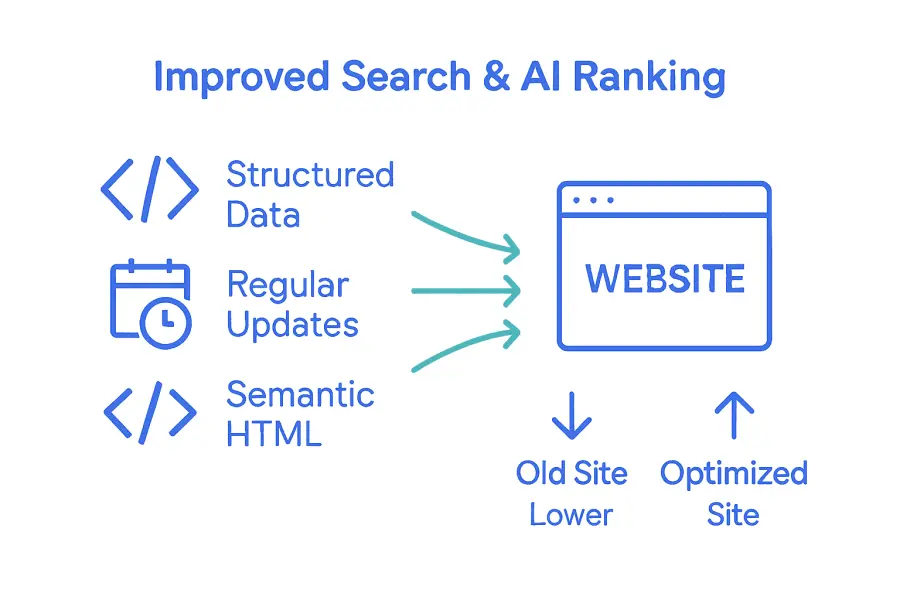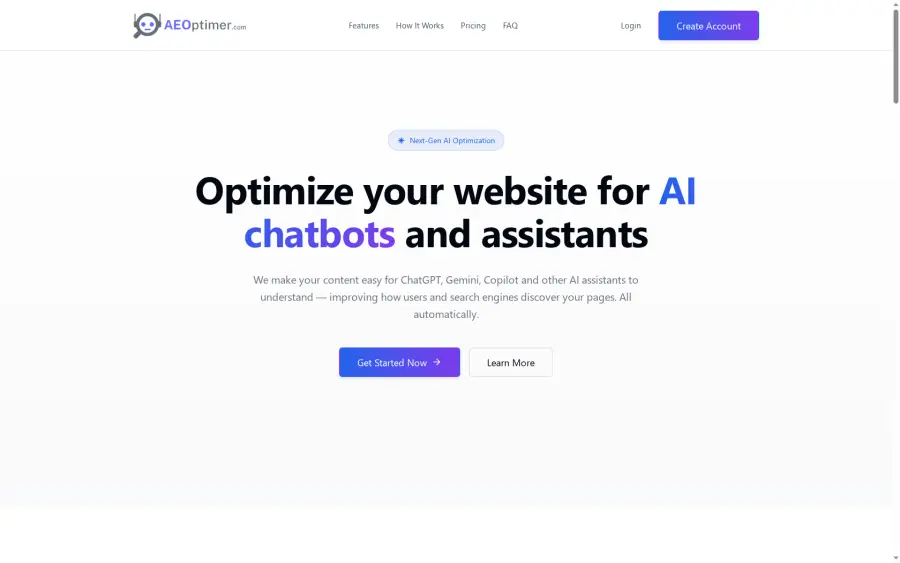Web Page Optimization Explained: Enhance Search and AI

Did you know that a single second delay in page load time can cause a 7 percent drop in conversions? As website visitors become more impatient, businesses face increasing pressure to deliver fast, user-friendly, and easily discoverable pages. Optimizing your web pages not only improves loading speed but also makes your content clearer for both search engines and AI tools, setting your site up for higher rankings and stronger visitor satisfaction.
Table of Contents
- What Is Web Page Optimization? Core Principles
- Types of Web Page Optimization Techniques
- How Optimization Improves Search and AI Visibility
- Key Elements: Structured Data and Content Updates
- Common Web Page Optimization Mistakes to Avoid
Key Takeaways
| Point | Details |
|---|---|
| Web Page Optimization Importance | Enhancing performance, visibility, and user experience is crucial for modern websites to succeed in a digital landscape. |
| Core Optimization Techniques | Implement key strategies like on-page SEO, technical SEO, and structured data to improve search visibility and user engagement. |
| Continuous Improvement | Optimization is an ongoing process that requires regular monitoring, testing, and updating to adapt to changing user behaviors and technologies. |
| Common Mistakes to Avoid | Prevent issues like inconsistent design, mobile neglect, and keyword stuffing to maintain effective web performance and visibility. |
What Is Web Page Optimization? Core Principles
Web page optimization represents a strategic approach to enhancing a website’s performance, visibility, and user experience across digital platforms. At its core, optimization transforms websites from static digital brochures into dynamic, intelligent interfaces that communicate effectively with search engines and AI assistants. The goal is simple: create web pages that load quickly, provide exceptional user experiences, and rank prominently in search results.
According to Cisin, effective web optimization hinges on several critical principles that directly impact user engagement and search performance. These core principles include:
- Performance Optimization: Ensuring rapid page load times
- Responsive Design: Creating mobile-friendly experiences
- Content Relevance: Developing high-quality, targeted content
- Structured Data Implementation: Adding machine-readable information
- Technical Compatibility: Supporting multiple devices and browsers
The technical landscape of web page optimization extends far beyond simple aesthetic adjustments. Modern optimization strategies require a holistic approach that considers technical infrastructure, content quality, and user interaction patterns. Websites must now be designed not just for human visitors but also for AI-powered search algorithms that continuously evaluate and rank digital content.
Successful web page optimization involves continuous monitoring, testing, and refinement. This means regularly analyzing page performance metrics, understanding user behavior patterns, and adapting your website’s structure and content to meet evolving digital standards. By implementing a comprehensive optimization strategy, businesses can dramatically improve their online visibility, attract more targeted traffic, and create more engaging digital experiences for their audience.
Types of Web Page Optimization Techniques
Web page optimization encompasses multiple strategic approaches designed to improve website performance, search visibility, and user engagement. According to GeeksforGeeks, these optimization techniques can be broadly categorized into several distinct yet interconnected domains that work together to enhance a website’s digital presence.
The primary types of web page optimization techniques include:
Here’s a summary comparing the main types of web page optimization techniques:
| Optimization Type | Focus Area | Key Benefits |
|---|---|---|
| On-Page SEO | Content & HTML | Better rankings Improved relevance |
| Off-Page SEO | External signals | Higher authority More backlinks |
| Technical SEO | Infrastructure & backend | Faster load times Improved crawlability |
| Local SEO | Geographic targeting | Local visibility Increased local traffic |
| Content Optimization | Content quality | Higher engagement Better audience targeting |
| Multivariate Optimization | A/B and multivariable testing | Enhanced conversions Data-driven improvements |
- On-Page SEO: Optimizing individual web page content and HTML source code
- Off-Page SEO: Building website authority through external signals and backlinks
- Technical SEO: Improving website infrastructure and backend performance
- Local SEO: Targeting geographically specific search results
- Content Optimization: Developing high-quality, relevant, and targeted content
Multivariate landing page optimization represents an advanced technique in this ecosystem. As Wikipedia explains, this method involves systematically testing multiple variations of web page elements to identify the most effective combinations for maximizing user engagement and conversion rates. This approach goes beyond traditional A/B testing by simultaneously evaluating multiple variables to create data-driven, high-performing web experiences.

Modern web page optimization is not a one-time task but an ongoing process of continuous improvement. Successful strategies require regular performance monitoring, user behavior analysis, and adaptive refinement. By integrating these diverse optimization techniques, businesses can create dynamic, intelligent websites that not only attract visitors but also provide exceptional user experiences across different devices and platforms.
How Optimization Improves Search and AI Visibility
Optimizing web content has evolved far beyond traditional search engine rankings, now focusing on creating intelligent, AI-friendly digital experiences that seamlessly connect with advanced algorithmic systems. As digital platforms become increasingly sophisticated, websites must adapt their strategies to communicate effectively with both human users and AI-powered search assistants.
According to Wikipedia, generative engine optimization (GEO) has emerged as a critical approach for improving visibility in AI-generated content results. This technique involves strategically crafting content that aligns with how generative AI models interpret and present information, ensuring websites can be accurately understood and prominently featured by intelligent search systems.
Key strategies for enhancing search and AI visibility include:
- Semantic Keyword Clustering: Organizing content around thematically related search terms
- Structured Data Implementation: Adding machine-readable metadata
- Natural Language Optimization: Writing content that mimics conversational AI patterns
- Context-Rich Content Development: Creating comprehensive, in-depth explanations
- Metadata Refinement: Improving technical signals for AI comprehension
Wikipedia highlights keyword clustering as another sophisticated technique for improving AI visibility. By grouping related search terms and creating comprehensive content around interconnected concepts, websites can signal greater relevance and depth to AI-powered search algorithms. This approach goes beyond traditional keyword targeting, focusing instead on creating holistic, contextually rich digital experiences that AI systems can easily parse and prioritize.
Key Elements: Structured Data and Content Updates
Structured data and consistent content updates represent the foundational pillars of modern web page optimization, transforming static websites into dynamic, intelligent digital platforms. These critical elements work synergistically to enhance search engine understanding, improve user experience, and maintain relevance in an ever-changing digital landscape.
According to Wikipedia, progressive enhancement provides a strategic framework for implementing structured data. This approach ensures that core content remains accessible while adding sophisticated layers of technical metadata that help search engines and AI assistants more accurately interpret and index website information. By prioritizing structured data, websites can create clear, machine-readable signals that significantly improve their discoverability across multiple platforms.
Key components of effective structured data and content update strategies include:
- Schema Markup: Adding standardized tags that explain content context
- Regular Content Refreshing: Updating information to maintain relevance
- Metadata Optimization: Improving descriptive tags and headers
- Semantic HTML Implementation: Using meaningful HTML elements
- Machine-Readable Annotations: Creating clear signals for AI indexing
Wikipedia highlights adaptive web design as another critical approach in this context. This methodology emphasizes creating flexible content structures that can dynamically adjust to different devices and search algorithms. By designing websites with adaptability and structured data in mind, businesses can ensure their digital presence remains robust, accessible, and continuously optimized across evolving technological landscapes.

Common Web Page Optimization Mistakes to Avoid
Web page optimization is a delicate balance between technical precision and user experience, where seemingly minor missteps can dramatically undermine a website’s performance and visibility. Understanding and avoiding common optimization pitfalls is crucial for maintaining a competitive digital presence that effectively communicates with both human users and AI search algorithms.
Research from ArXiv highlights the critical challenge of maintaining consistent web appearance across different devices and platforms. This study emphasizes that many optimization efforts fail by focusing too narrowly on individual aspects while neglecting the holistic user experience. Common mistakes include:
- Inconsistent Responsive Design: Creating pages that look different across devices
- Overloading with Heavy Media: Implementing graphics and scripts that slow page performance
- Neglecting Mobile Optimization: Failing to adapt content for smaller screens
- Ignoring Structured Data: Not implementing machine-readable metadata
- Keyword Stuffing: Overusing keywords at the expense of natural content flow
According to ArXiv, successful web optimization requires a comprehensive strategy that goes beyond surface-level adjustments. The research underscores that many websites make the critical error of treating optimization as a one-time task rather than an ongoing process of continuous improvement. By approaching web page optimization as a dynamic, adaptive endeavor, businesses can create more resilient digital experiences that remain effective across changing technological landscapes and user expectations.
Unlock the Full Potential of Your Website with Automated Web Page Optimization
The article explains that modern web page optimization is about more than just technical tweaks or aesthetic improvements. It highlights the challenge of continuously updating your site with structured data, AI-friendly content, and semantic keyword clustering to keep up with evolving AI algorithms and search engines. If you have struggled with slow manual updates, inconsistent mobile experiences, or worry about your content being overlooked by AI assistants like ChatGPT or Gemini, you are not alone. These are common pain points that can hurt visibility and traffic even when your website looks great.

Take control of your online presence effortlessly with aeoptimer.com. Our SaaS platform automates the complex task of optimization by crawling, analyzing, and updating your pages every month. It adds structured data and AI-optimized enhancements without changing your website’s visual design. This keeps your content fresh, relevant, and highly discoverable across search engines and AI tools. Don’t let your website fall behind in the AI-driven digital landscape. Visit aeoptimer.com to explore how seamless, ongoing optimization can boost your rankings and attract AI-based traffic now.
Frequently Asked Questions
What is web page optimization?
Web page optimization is a strategy aimed at improving a website’s performance, visibility, and user experience, making it more effective for both human users and AI algorithms.
What are the core principles of web page optimization?
The core principles include performance optimization, responsive design, content relevance, structured data implementation, and technical compatibility, all aimed at enhancing website effectiveness.
How does optimization improve search engine and AI visibility?
Optimization improves visibility by creating intelligent, AI-friendly content that aligns with how algorithms interpret information, employing techniques like semantic keyword clustering and structured data.
What are common mistakes to avoid in web page optimization?
Common mistakes include inconsistent responsive design, overloading pages with heavy media, neglecting mobile optimization, ignoring structured data, and keyword stuffing, all of which can harm website performance.





